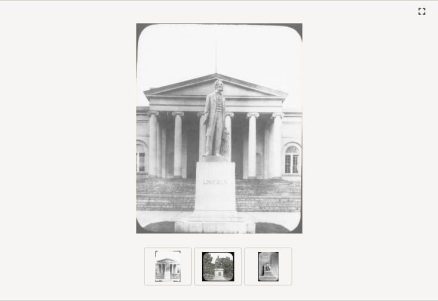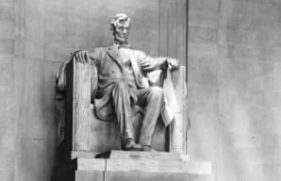
Abraham Lincoln Statue, Washington, DC
Civil War and Reconstruction (1850-1877)
A National Archives Foundation educational resource using primary sources from the National Archives

Published By:
Historical Era:
Thinking Skill:
Bloom’s Taxonomy:
Grade Level:
This activity is intended as wrap-up to a unit on the Civil War, or for use when studying monuments and memorials. For grades 6-12. Approximate time needed is 30 minutes.
To begin, ask students to define monument or memorial. After discussing definitions, ask students if they can think of a monument or memorial in their town, city, county or state. What does the monument memorialize? Why do we memorialize people through sculptures?
Tell students that they will be analyzing three statues created in Washington, DC, to memorialize our 16th President – Abraham Lincoln. Present the activity to the entire class. Model careful analysis with students. Then divide the class into at least 3 groups with each group analyzing one of the statues. Remind them to use the blue buttons at the bottom of the photographs to look more closely at each one.
For each statue, ask students to consider the following:
Bring the class back together and ask students to report on each individual statue as you list out the details. After discussing statues individually, ask students to note any major similarities and differences between the three depictions.
Some of the similarities and differences they may notice include:
After discussing the similarities and differences, if desired, share historical details of each individual statue’s creation:
Abraham Lincoln by Lot Flannery (1868)
The first public statue of Abraham Lincoln, Lot Flannery’s depiction is located in front of DC’s Old City Hall (District of Columbia Court of Appeals). Lot Flannery claimed that he actually was at Ford’s Theatre the night of the assassination and was the only sculptor of Lincoln to have known him in life. In its original depiction, the statue was located on top of a tall pillar but it has since been moved to a shorter base. It was unveiled on the third anniversary of Lincoln’s death at the height of his successor Andrew Johnson’s impeachment trial.
Emancipation Memorial by Thomas Ball (1876)
The Emancipation Memorial (also known as the Freedman’s Memorial, Freedom’s Memorial, or the Emancipation Group) was created by sculptor Thomas Ball. The focus is on Abraham Lincoln as the Great Emancipator, as it features the 14th President standing while a formerly enslaved freedman begins to rise. Located in Lincoln Park in Washington, DC, the statue was paid for entirely by the donations of former enslaved people. It was dedicated 11 years after Abraham Lincoln’s assassination on April 14, 1876, in an event that featured a speech from orator Frederick Douglass.
Abraham Lincoln by Daniel Chester French (1920)
Originally designed to be 10 feet tall, the likeness was 19 feet high when completed, so that the cavernous chamber would not dwarf the statue. Construction began on the memorial to Lincoln in 1915, fifty years after his assassination. American sculptor Daniel Chester French designed the statue to honor the 16th President. In describing his tribute to Lincoln, French said: “The memorial tells you just what manner of man you are come to pay homage to; his simplicity, his grandeur, and his power.”
The Lincoln Memorial has been the backdrop for many important public protests and events since its completion. It was on the memorial’s steps that singer Marian Anderson gave her Easter Sunday concert in 1939 after being turned away from Constitution Hall by the Daughters of the American Revolution, and where Dr. Martin Luther King, Jr., delivered his “I Have a Dream” speech in August 1963.
Direct students’ attention to the conclusion questions under “When You’re Done.” Discuss their thoughts.
This comparative analysis activity involves comparing and contrasting three statues of Abraham Lincoln in Washington, DC–Abraham Lincoln by Lot Flannery from 1868, Emancipation Memorial by Thomas Ball from 1876, and Abraham Lincoln by Daniel Chester French from 1920. Students will consider the similarities and differences between these three depictions and discuss the qualities of Abraham Lincoln that they emphasize.


